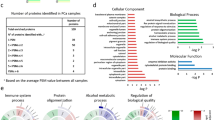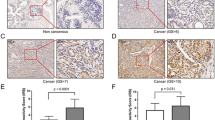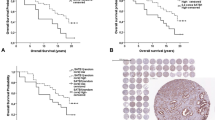Abstract
Connexins (Cxs) are a family of transmembrane proteins that build cell-to-cell channels in gap junctions. Gap junctions composed of Cxs have an essential role in intercellular communication, adhesion and cell differentiation. Several studies investigated the role of connexin43 (Cx43) in different carcinomas; however, none investigated its prognostic role in prostate cancer. Cx43 expression and relationship with established prognostic features were assessed in a cohort of 102 patients treated with radical prostatectomy for clinically localized prostate adenocarcinoma. Cx43 expression in prostate cancer was significantly associated with established features indicative of worse prognosis, such as follow-up time (P<0.001) and preoperative PSA (P<0.007). Patients with lower Cx43 expressions in tumours have shorter follow-up time, which indicated shorter disease-free survival and higher preoperative PSA values. Furthermore, tumours with positive surgical margins (P<0.001) showed significantly lower Cx43 expression compared with tumours without this feature. In univariate (P<0.001) and multivariate (P=0.014) analyses, decreased Cx43 expression was found to be a significant predictor of biochemical recurrence free-survival. Study results show the association of decreased Cx43 expression with prostate cancer progression. Moreover, Cx43 could serve as an additional prognostic marker and used together with traditional prognostic markers might help in further stratifying the risk of disease progression in patients with prostate cancer.
This is a preview of subscription content, access via your institution
Access options
Subscribe to this journal
Receive 4 print issues and online access
$259.00 per year
only $64.75 per issue
Buy this article
- Purchase on Springer Link
- Instant access to full article PDF
Prices may be subject to local taxes which are calculated during checkout




Similar content being viewed by others
References
Fukushima M, Hattori Y, Yoshizawa T, Maitani Y . Combination of non-viral connexin 43 gene therapy and docetaxel inhibits the growth of human prostate cancer in mice. Int J Oncol 2007; 30: 225–231.
Mehta PP, Perez-Stable C, Nadji M, Mian M, Asotra K, Ross BA . Suppression of human prostate cancer cell growth by forced expression of connexin genes. Dev Genet 1999; 24: 91–110.
Wang M, Berthoud VM, Beyer EC . Connexin43 increases the sensitivity of prostate cancer cells to TNFα-induced apoptosis. J Cell Sci 2007; 120: 320–329.
Govindarajan R, Zhao S, Song XH, Guo RJ, Wheelock M, Johnson KR et al. Impaired trafficking of connexins in androgen-independent human prostate cancer cell lines and its migration by α-catenin. J Biol Chem 2002; 277: 50087–50097.
Vinken M, Decrock E, De Vuyst E, Ponsaerts R, D′hondt C, Bultynck G et al. Connexins: sensors and regulators of cell cycling. Biochim Biophys Acta 2010; (e-pub ahead of print) doi:10.1016/j.bbcan.2010.08.004.
Brehm R, Ruttinger C, Fischer P, Gashaw I, Winterhager E, Kliesch S et al. Transition from preinvasive carcinoma in situ to seminoma is accompanied by a reduction of connexin 43 expression in Sertoli cells and germ cells. Neoplasia 2006; 8: 499–509.
Habermann H, Ray V, Habremann W, Prins GS . Alterations in gap junction protein expression in human benign prostatic hyperplasia and prostate cancer. J Urol 2002; 167: 655–660.
Carruba G, Stefano R, Cocciadiferro L, Saladino F, Di Cristina A, Tokar E et al. Intercellular communication and human prostate carcinogenesis. Ann N Y Acad Sci 2002; 963: 156–168.
Li Z, Zhou Z, Welch DR, Donahue HJ . Expressing connexin 43 in breast cancer cells reduces their metastasis to lungs. Clin Exp Metastasis 2008; 25: 893–901.
Xu HT, Li QC, Zhang YX, Zhao Y, Liu Y, Yang ZQ et al. Connexin 43 recruits E-cadherin expression and inhibits the malignant behaviour of lung cancer cells. Folia Histochem Cytobiol 2008; 46: 315–321.
Hossain MZ, Jagdale AB, Ao P, LeCiel C, Huang RP, Boynton AL . Impaired expression and posttranslational processing of connexin43 and downregulation of gap junctional communication in neoplastic human prostate cells. Prostate 1999; 38: 55–59.
Decrock E, Vinken M, De Vuyst E, Krisko DV, D'Herde K, Vanhaecke T et al. Connexin-related signaling in cell death: to live or let die? Cell Death Differ 2009; 16: 524–536.
Tsai H, Werber J, Davia MO, Edelman M, Tanaka KE, Melman A et al. Reduced connexin 43 expression in high grade, human prostatic adenocarcinoma cells. Bichem Biophys Res Commun 1996; 227: 64–69.
Sobin LH, Wittekind C (eds). International Union Against Cancer (UICC): TNM classification of malignant tumours, 5th ed. Wiley Liss: New York, USA, 1997.
Umhauer S, Ruch RJ, Fanning J . Gap junctional intercellular communication and connexin 43 expression in ovarian carcinoma. Am J Obstet Gynecol 2000; 182: 999–1000.
Nomura S, Maeda K, Noda E, Inoue T, Fukunaga S, Nagahara H et al. Clinical significance of the expression of connexin 26 in colorectal cancer. J Exp Clin Cancer Res 2010; 29: 79.
Liu X, Furuya T, Li D, Xu J, Cao X, Li Q et al. Connexin 26 expression correlates with less aggressive phenotype of intestinal type-gastric carcinomas. Int J Mol Med 2010; 25: 709–716.
Inose T, Kato H, Kimura H, Faried A, Tanaka N, Sakai M et al. Correlation between connexin 26 expression and poor prognosis of esophageal squamous cell carcinoma. Ann Surg Oncol 2009; 16: 1704–1710.
Conklin C, Huntsman D, Yorida E, Makretsov N, Turbin D, Bechberger JF et al. Tissue microarray analysis of connexin expression and its prognostic significance in human breast cancer. Cancer Lett 2007; 255: 284–294.
Author information
Authors and Affiliations
Corresponding author
Ethics declarations
Competing interests
The authors declare no conflict of interest.
Rights and permissions
About this article
Cite this article
Benko, G., Spajić, B., Demirović, A. et al. Prognostic value of connexin43 expression in patients with clinically localized prostate cancer. Prostate Cancer Prostatic Dis 14, 90–95 (2011). https://doi.org/10.1038/pcan.2010.51
Received:
Revised:
Accepted:
Published:
Issue Date:
DOI: https://doi.org/10.1038/pcan.2010.51
Keywords
This article is cited by
-
Connexin 43 (Cx43) Expression in Laryngeal Squamous Cell Carcinomas: Preliminary Data on Its Possible Prognostic Role
Head and Neck Pathology (2016)
-
A predictive role for noncancerous prostate cells: low connexin-26 expression in radical prostatectomy tissues predicts metastasis
British Journal of Cancer (2012)
-
The role of connexins in prostate cancer promotion and progression
Nature Reviews Urology (2012)



